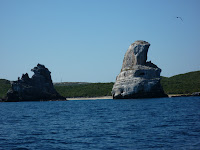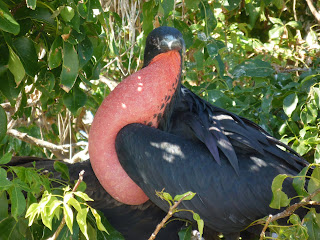Preparing to set out to sea requires food, fuel, paper work and starting the engine; everything worked except the engine. A few hours of trouble shooting with the starter removed, disassembled, etc. and the diesel started ... we still don't know why ... this would prove temper-mental.
The seas are confused as we escape the jetty heading out between the islands and the Mazatlan shore line. I raise the main and lose the halyard (probably not my last mistake). With Steve standing on the boom, fishing pole in hand and me holding his legs against the battering seas, we recover the halyard and set sail south. Our destination is Isla Isabella, a bird sanctuary, eighteen miles off the coast of Estado Nayarit , Mexico (we will not venture near the Maria Islands; the Mexican penal colony does not allow visitors and we do not wish to become residents). The clear night turns to overcast with a steady broad reach southeast. It is a beautiful sail with light rains on occasion.
Mid day brings us to Isla Isabella; we drop anchor in the bay where it is known to eat ground tackle with its rocky bottom and uncertain hold. Hundreds of frigate birds fly overhead; why? ....
 Steve, Betty, Billy and I form up the beach party to visit the fish camp and birds. The protected birds sit in the short trees and stare at us; no cause for alarm here. It looks like a spartan life in the fish camp; few comforts, nice weather, thousands of birds.
Steve, Betty, Billy and I form up the beach party to visit the fish camp and birds. The protected birds sit in the short trees and stare at us; no cause for alarm here. It looks like a spartan life in the fish camp; few comforts, nice weather, thousands of birds.Our anchor comes up and we set sail for San Blas. Our charts no longer provide details of the coast line so we need to watch the lights as we near the shore. With uncertain winds, I try to start the engine, twice ... no luck ... that must be why we are on a sail boat. Midnight brings us to the bay of Mantanchen where we anchor; Steve and I toast our passage with tequila and rest.
San Blas is the mosquito sanctuary of the coast; the many palapas along the bay continuously burn palm cuttings to smoke out the insects. The rain forest behind the beach and surrounding the town is a swamp; the river delta runs in every direction and provides a perfect breading ground. I negotiate with a palapa owner to drive us around the swamp, into San Blas; we hike around this old, historic town and are the only tourists in this remote enclave today. The old and new church stand side by side in the central square. Two blocks away pickup trucks are loading up with troops in flack jackets carrying automatic weapons; the drug war is hot in Mexico; the outcome seams uncertain. A restaurant where the beer is cold and the food good tops off the day. Then back to the beach where Steve, Tina and the kiddies play in the shallow water. Everyone here is a local, enjoying family day (Sunday) on the bay.

 We start the engine in the afternoon (luck is with us) and motor farther down the coast to Chacala bay; anchored bow and stern, steadied against the surf rolling into the beach for the night. The scenery here is dramatically different from the desert in Baja; palms reach to the sky; each day portends the possibility of rain; the weather has become warmer, but not hot. We run the reef on the northern entrance to Banderas Bay and anchor in the shelter of Punta de Mita. When Steve visited here in his youth ... there was nothing but beach sand; now it is a Four Seasons resort with condominiums as far as the eye can see; so much for progress. It is a short sail into Puerto Vallarta and Paradise Village Marina. I leave Seahorse V and friends to go home for the holidays ... looking forward to returning .....
We start the engine in the afternoon (luck is with us) and motor farther down the coast to Chacala bay; anchored bow and stern, steadied against the surf rolling into the beach for the night. The scenery here is dramatically different from the desert in Baja; palms reach to the sky; each day portends the possibility of rain; the weather has become warmer, but not hot. We run the reef on the northern entrance to Banderas Bay and anchor in the shelter of Punta de Mita. When Steve visited here in his youth ... there was nothing but beach sand; now it is a Four Seasons resort with condominiums as far as the eye can see; so much for progress. It is a short sail into Puerto Vallarta and Paradise Village Marina. I leave Seahorse V and friends to go home for the holidays ... looking forward to returning .....(San Blas photo from Google Earth)















































